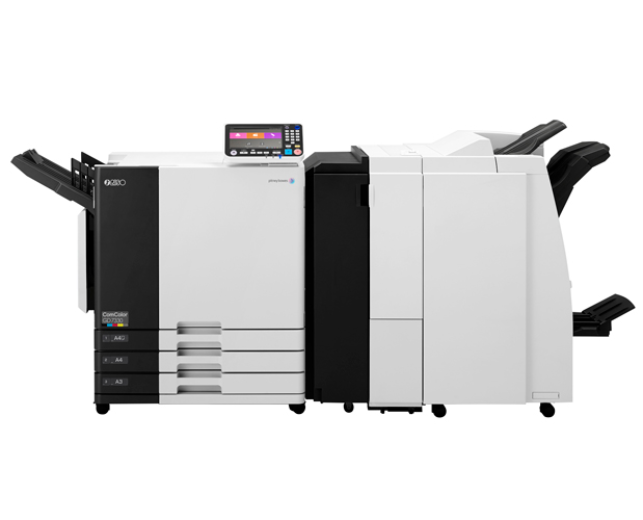Business Class Inkjet
December 22nd, 2020 by Paul Perez
In previous blogs, we touched on new developments in Inkjet technology from a high-level macro perspective. Now that business class inkjet has had some time to carve out its niche, we felt it necessary to dive into it a little more precisely. (We will be ignoring desktop and industrial inkjet units in this blog) We can start by establishing this - Inkjet is not for everyone. There are some phenomenal benefits, but also significant drawbacks. Your particular workflow and needs are what should be kept in mind while reading. If they line up, then inkjet may be a good fit. If not, it would probably be best to avoid it.

Let's address the elephant in the room and work our way into where inkjet makes the most significant impact.
Business level inkjet devices require printing on very particular substrates to work correctly. True to the name, inkjet uses ink, and ink is wet. For this wet ink to transfer to paper correctly, it must be dried. Because inkjet does not use heat in the printing process, the ink must be absorbed into the substrate to dry, which means that coated stocks are out of the question. Coated stocks are typically glossy sheets that provide an extra shine to the print. This coating prevents ink from absorbing and causes it to sit on top of the substrate, eventually smearing.
Furthermore, because inkjet requires ink to be absorbed into the substrate, it takes on a "flat" appearance compared to the toner or offset print's glossy pop. If magazine quality graphics are a need for your organization, a business-class inkjet is probably not for you. A Digital Toner Press may be worth looking at.
So now we know that business class inkjet does not do so well with high-end graphics. So then, what is it suitable for? The phrase used lately to describe its niche is "communication color." This refers to the use of color to facilitate a message. Color has been proven to increase both message understanding, as well as short- and long-term message retention. Whether it be memorandum for business, psalms for Churches, critical areas in construction drawings, or coloring sheets for children, color helps highlight areas requiring specific attention. Additionally, individual colors influence human understanding and feelings. There is particular psychology behind making stop signs red and doctor's lab coats white.
Yes, toner MFP's can use color to communicate in the same way.
The thing that makes inkjet intriguing is the pricing model. Most businesses are accustomed to the cost per page model of toner devices. Inkjet has some similarities, but a huge difference as well. With toner machines, all parts, labor, and toner are supplied by the vendor, and in return, the customer pays a cost per copy or "CPC"– This CPC varies with machines but can be anywhere from $.04 to $.1 per print. With inkjet, things are slightly different. There is still a very low CPC covering parts and labor, but it does not cover ink. Ink is purchased separately by the customer.
The separate purchase of ink sounds expensive and tends to throw people off. It is sometimes seen as an "extra cost" but can significantly decrease from toner CPC's. Think about the blue text and underline in hyperlinks like this one to our Inkjet page - Function4 Inkjet. If one of these hyperlinks happens to get printed on a toner device, a full-color CPC will be triggered. Though you are using a minimal amount of blue toner, it is still triggering a full-color print and billed as such. On the inkjet side, because the customer purchases ink, that blue hyperlink only costs as much as the ink used in printing it – a fraction of a penny.
Along with ink usage, the print volume should be evaluated when considering ink. Inkjet devices are designed to print considerable volume and do it quickly. While most business-level toner devices run in the 40-60 page per minute areas, business-class inkjet can push up to 190 pages per minute, making inkjet equipment slightly more expensive than traditional toner-based units. Inkjet shows the most value is very low CPC – so for inkjet to make financial sense, there must be enough volume printed for the decrease in CPC to justify the increase in equipment cost. There is a break-even point for every business's workflow. A reputable vendor can put together a cost calculation of what printed jobs would cost with inkjet vs. toner. Once the break-even point is identified, every printed sheet above that point represents savings.
Most businesses that have recently converted to inkjet did so for one of two reasons.
- They require color but have avoided it because color clicks on toner devices are too costly.
- They have always used a color toner device and realized the inkjet quality is suitable for their workflow, and savings could be achieved.
The best ownership case for inkjet lies somewhere between medium to high amounts of color volume printed on an uncoated substrate. If you find your business in that realm, reach out to an adviser about a cost analysis. After an evaluation, you may find that inkjet could provide significant savings for your needs.
Posted in: Business Technology

